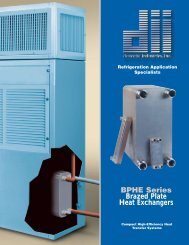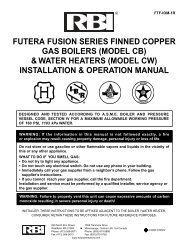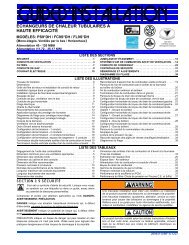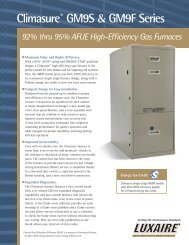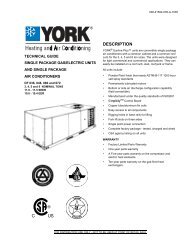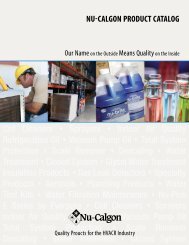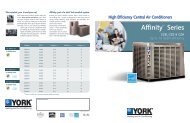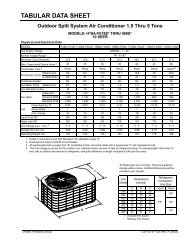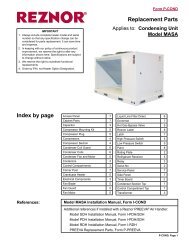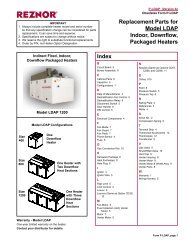Y-IM-Single Package AC and Single Package Gas/Electric Units ...
Y-IM-Single Package AC and Single Package Gas/Electric Units ...
Y-IM-Single Package AC and Single Package Gas/Electric Units ...
Create successful ePaper yourself
Turn your PDF publications into a flip-book with our unique Google optimized e-Paper software.
127083-Y<strong>IM</strong>-B-0606<br />
1. Turn off all power to the unit.<br />
2. Using the outlet pressure port on the gas valve, connect<br />
a manometer to monitor the manifold pressure.<br />
3. Remove plastic cap covering HI <strong>and</strong> LO pressure adjustment<br />
screws.<br />
4. Turn on power to the unit.<br />
5. Set thermostat to call for second stage heat <strong>and</strong> start furnace.<br />
6. If necessary, using a screwdriver, turn the second stage<br />
adjustment screw (adjacent to the “HI” marking on the<br />
valve) clockwise to increase manifold pressure or counterclockwise<br />
to decrease manifold pressure. Be sure<br />
not to over-fire the unit on second stage.<br />
7. After the high manifold pressure has been checked,<br />
adjust the thermostat to call for first stage heat.<br />
8. If necessary, using a screwdriver, turn the first stage<br />
adjustment screw (adjacent to the “LO” marking on the<br />
valve) clockwise to increase manifold pressure or<br />
counterclockwise to decrease manifold pressure. Be<br />
sure not to under-fire the unit on first stage.<br />
9. Once pressure has been checked, replace the plastic<br />
cap covering the HI <strong>and</strong> LO pressure adjustment screws.<br />
NOTE: When using natural gas, the manifold pressure for<br />
second stage (100% input) should be 3.5 IWG ±<br />
0.3. The manifold pressure for first stage (60%<br />
input) when using natural gas should be 1.5 IWG ±<br />
0.3.<br />
TABLE 48: GAS HEAT STAGES<br />
# of Burner Tubes<br />
CHECKING GAS INPUT<br />
NATURAL GAS<br />
2nd Stage<br />
Input (100%<br />
Btuh)<br />
1st Stage<br />
Input (60%<br />
Btuh)<br />
4 120,000 72,000<br />
6 180,000 108,000<br />
8 240,000 144,000<br />
This unit has two stages of gas heat. The first stage is 60% of<br />
the full fire input <strong>and</strong> is considered the minimum input for the<br />
furnace. The intended input for each furnace is shown in the<br />
table below. The following Table applies to units operating on<br />
60 Hz power only.<br />
To determine the rate of gas flow (Second Stage).<br />
1. Turn off all other gas appliances connected to the gas<br />
meter.<br />
2. Turn on the furnace <strong>and</strong> make sure the thermostat is<br />
calling for Second stage (100% input) heat.<br />
3. Measure the time needed for one revolution of the h<strong>and</strong><br />
on the smallest dial on the meter. A typical gas meter<br />
has a 1/2 or a 1 cubic foot test dial.<br />
4. Using the number of seconds it takes for one revolution<br />
of the dial, calculate the cubic feet of gas consumed per<br />
hour. (See example below).<br />
5. If necessary, adjust the high pressure regulator as discussed<br />
in the section “Manifold <strong>Gas</strong> Pressure Adjustment”.<br />
Be sure not to over-fire the furnace on Second<br />
stage. If in doubt, it is better to leave the Second stage of<br />
the furnace slightly under-fired. Repeat Steps 1-5.<br />
To determine the rate of gas flow (First Stage)<br />
1. Turn off all other gas appliances connected to the gas<br />
meter.<br />
2. Turn on the furnace <strong>and</strong> make sure the thermostat is<br />
calling for first stage (60% input) heat.<br />
3. Even when the thermostat is calling for first stage heat,<br />
the unit will light on second stage <strong>and</strong> will run on Second<br />
stage for 1 minute. Allow this one-minute time period to<br />
expire <strong>and</strong> be certain the unit is running on first stage.<br />
4. Measure the time needed for one revolution of the h<strong>and</strong><br />
on the smallest dial on the meter. A typical gas meter<br />
has a 1/2 or a 1 cubic foot test dial.<br />
5. Using the number of seconds it takes for one revolution<br />
of the dial, calculate the cubic feet of gas consumed per<br />
hour (See example below).<br />
6. If necessary, adjust the low pressure regulator as discussed<br />
in the section “Manifold <strong>Gas</strong> Pressure Adjustment”.<br />
Be sure not to under-fire the furnace on first<br />
stage. If in doubt, it is better to leave the first stage of the<br />
furnace slightly over-fired (greater than 60% input).<br />
Repeat Steps 1-6.<br />
Unitary Products Group 55



